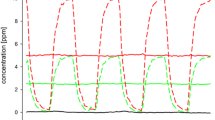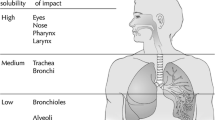Abstract.
Objectives: For risk assessments of solvents the knowledge on chemosensory irritation effects is important, but the methodological base for that is incomplete. The psychological approach measuring chemosensory irritations leans on perceived symptoms and self-reported changes of well being. Characteristics assessing the validity of such psychological approaches are presented. Methods: The article is based on 14 experimental inhalation studies with (mostly) 4-h exposures to acetone, 2-butanone, ethanol, ethyl acetate, ethyl benzene, iso-propanol, 1-octanol, and styrene. The profiles of exposure include constant and changing concentrations using the range of the German maximum concentrations at the workplace (MAK) list. Irritations (eyes and nose), olfactory symptoms (odour), and annoyance are the dependent variables measured by ratings. Young and healthy subjects (n=160), – partially, subjects with self-reported odour sensitivity (measured by items from the questionnaire on chemical and general environmental sensitivity) – were investigated. Results: The reliability of ratings is sufficient. Dose–response relationships for perceived odour and annoyance are stronger than those for irritations. A ranked order of the size of effect (related to the values before exposure) for the substances investigated shows correspondence between odour and annoyance; that for irritation differs. Within the limits of the MAK list, perceived irritations are not correlated to annoyance, whereas perceived bad smell correlates significantly to annoyance. Reversibility of the self-reported effects to approximately the pre-exposure level can be shown 1 h after cessation of the experimental exposure for the "normal" subjects. Influences of trait anxiety and chemical sensitivity on reports of annoyance, bad odour or irritation are only weak. Conclusion: The psychological approach of repeated measurements for self-reported irritation includes distinctive advantages compared with other methods, the simple and repeated availability during exposure, the sufficient reliability and dose–response relationship, and the comparability between substances by means of effect size. The extension of the concept of "chemosensory irritations" on reports for annoyance and bad smell can be recommended.
Similar content being viewed by others
Author information
Authors and Affiliations
Additional information
Electronic Publication
Rights and permissions
About this article
Cite this article
Seeber, A., van Thriel, C., Haumann, K. et al. Psychological reactions related to chemosensory irritation. Int Arch Occup Environ Health 75, 314–325 (2002). https://doi.org/10.1007/s00420-002-0316-6
Received:
Accepted:
Issue Date:
DOI: https://doi.org/10.1007/s00420-002-0316-6




